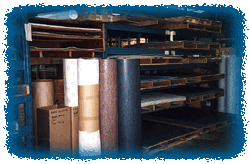Gasket Seating
There are two major factors to be considered
with regard to gasket seating. The first is the gasket material
itself. The ASME Unfires Pressure Vessel Section VIII, Division 1
defines minimum design seating stresses for a variety of gasket
materials. These design seating stresses range from zero psi for
so-called self-sealing gasket types such a low durometer
elastomers and O-rings to 26,000 psi to properly seal solid flat
metal gaskets. Between these two extremes there are a multitude of
materials available to the designer enabling him to make a
selection based upon the specific operating conditions under
investigation.
The second major factor to take into
consideration must be the surface finish of the gasket seating
surface. As a general rule, it is necessary to have a relatively
rough gasket seating surface for elastomeric and PTFE gaskets on
the order of magnitude of 500 microinches. Solid metal gaskets
normally require a surface finish not rougher than 63 microinches.
Semi-metallic ets such as spiralwound fall between these two
general types. The reason for the difference is that with
non-metallic gaskets such as rubber, there must be sufficient
roughness on the gasket seating surfaces to bite into the gasket
thereby preventing excessive extrusion and increasing resistance
to gasket blowout. In the case of solid metal gaskets, extremely
high unit loads are required to flow the gasket into imperfections
on the gasket seating surfaces. This requires that the gasket
seating surfaces be as smooth as possible to ensure an efficient
seal.
 designer and there is no such thing as a single optimum
gasket surface finish for gasket seating surface is further
complicated by the type of the flange design. For example a
totally enclosed facing such as tongue and groove will
permit the use of a much smoother gasket seating surface
that can be tolerated with a raised face.
designer and there is no such thing as a single optimum
gasket surface finish for gasket seating surface is further
complicated by the type of the flange design. For example a
totally enclosed facing such as tongue and groove will
permit the use of a much smoother gasket seating surface
that can be tolerated with a raised face.